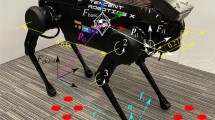Abstract
We describe the design, construction and control of a quadruped robot which walks on uneven terrain. A control system which produces a statically stable gait has been implemented; results showing a straight and turning gait are presented. The control of quadruped robots poses interesting challenges due to a small stability margin (when compared to hexapods for example). For this reason most implemented systems for outdoor walking on uneven terrain have been hexapods. The system described here has the added virtue of using very few inexpensive sensors and actuators. One of the aims of this work is to build a reduced complexity (low power, low mass and direct drive) walking robot for statically stable walking. The other aim is to compare the performance of this robot with a wheeled robot roughly the same size and weight. In this paper we report on progress towards the first of these two goals using a traverse across an obstacle field as an example.
Similar content being viewed by others
References
Bares, J. and Whittaker, W. 1993. Configuration of autonomous walkers for extreme terrain. International Journal of Robotics Research, 12(6):535-559.
Beer, R.D., Chiel, H.J., and Sterling, L.S. 1990. A biological perspective on autonomous agent design. Robotics and Autonomous Systems, 6:169-186.
Brooks, R.A. 1989. A robot that walks: Emergent behaviors from a carefully evolved network. Neural Computation, 1(2):365-382.
de Santos, P.G. and Jimenez, M.A. 1995. Generation of discontinuous gaits for quadruped walking vehicles. Journal of Robotic Systems, 12(2):599-611.
Ferrell, C. 1995. Global behavior via cooperative local control. Autonomous Robots, 2(2):105-125.
Gat, E. 1995. Towards principaled experimental study of autonomous mobile robots. Autonomous Robots.
Hirose, S. 1984. A study of design and control of a quadruped walking vehicle. International Journal of Robotics Research, 3(2):113-133.
Hirose, S. and Kunieda, O. 1991. Generalized standard foot trajectory for a quadruped walking vehicle. The International Journal of Robotics Research, 10(1):3-12.
Hirose, S., Kikuchi, H., and Umetani, Y. 1986. The standard circular gait of a quadruped walking vehicle. Advanced Robotics, 1(2):143-164.
Hodgins, J.K. and Raibert, M.H. 1991. Adjusting step length for rough terrain locomotion. IEEE Transaction on Robotics and Automation, 7(3):289-298.
Krotkov, E. and Hoffman, R. 1994. Terrain mapping for a walking planetary rover. IEEE Transactions on Robotics and Automation, 10(6):728-739.
Matthies, L., Gat, E., Harrison, R., Wilcox, B., Volpe, R., and Litwin, T. 1995. Mars microrover navigation: Performance evaluation and enhancement. Autonomous Robots.
McGhee, R.B. 1967. Finite state control of quadruped locomotion. Simulation, pp. 135-140.
Messuri, D.A. and Klein, C.A. 1985. Automatic body regulation for maintaining stability of a legged vehicle during rough terrain locomotion. IEEE Journal of Robotics and Automation, 1(3):132-141.
Nagy, P., Desa, S., and Whittaker, W.L. 1994. Energy-based stability measures for reliable locomotion of statically stable walkers: Theory and application. The International Journal of Robotics Research, 13(3):272-287.
Raibert, M.H. 1986. Legged Robots that Balance. The MIT Press: Cambridge, Massachusetts.
Simmons, R. 1994. Structured control for autonomous robots. IEEE Transactions on Robotics and Automation, 10(1):34-43.
Song, S. and Waldron, K.J. 1989. Machines that Walk: The Adaptive Suspension Vehicle. The MIT Press: Cambridge, Massachusetts.
Sukhatme, G.S. and Bekey, G.A. 1996. Multicriteria evaluation of a planetary rover. In Proc. Workshop on Planetary Rover Technology and Systems, 1996 IEEE Int. Conf. on Robotics and Automation.
Tsukagoshi, H., Hirose, S., and Yoneda, K. 1996. Maneuvering operations of the quadruped walking robot on the slope. In Proc. 1996 IEEE/RSJ Int. Conf. on Intelligent Robots and Systems, pp. 863-869.
Author information
Authors and Affiliations
Rights and permissions
About this article
Cite this article
Sukhatme, G.S. The Design and Control of a Prototype Quadruped Microrover. Autonomous Robots 4, 211–220 (1997). https://doi.org/10.1023/A:1008817816802
Issue Date:
DOI: https://doi.org/10.1023/A:1008817816802




